To select the appropriate mobility aid, begin by evaluating your specific mobility challenges, living environment, and safety needs. Consider whether a cane, walker, or wheelchair best supports your activity levels, space constraints, and terrain. Comfort, stability, and ease of use are essential, so try different options and consult healthcare professionals for personalized advice. Budget and safety features also matter. If you want detailed tips, there’s more to explore to help you make the best choice.
Key Takeaways
- Assess individual mobility needs, including balance, strength, and daily activity requirements, to identify the most suitable aid.
- Consider the living environment and terrain, choosing aids that offer stability and safety indoors and outdoors.
- Evaluate device ergonomics, comfort, and portability to ensure ease of use and promote confidence in mobility.
- Consult healthcare professionals for personalized recommendations and proper device usage guidance.
- Compare costs, insurance options, and trial different aids to find the best fit for safety, comfort, and budget.
Assessing Your Mobility Needs and Limitations
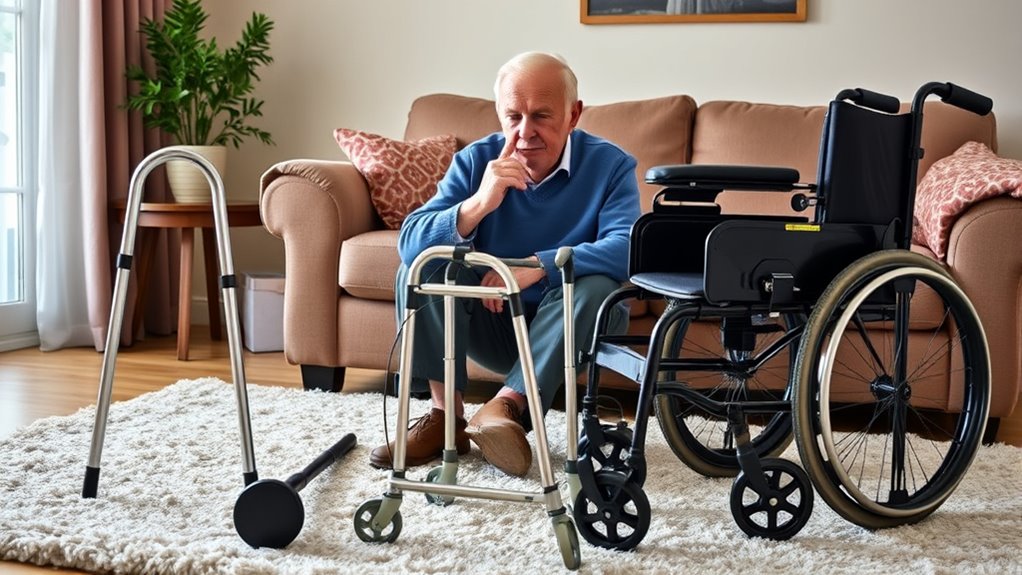
Before choosing a mobility aid, you need to understand your specific needs and limitations. Many mobility myths can lead to confusion, such as believing only severe disabilities require assistive technology. However, assistive devices aren’t just for severe cases; they enhance safety and independence for various mobility levels. Assess whether you struggle with balance, strength, or endurance, and identify which activities are most affected—walking, standing, or climbing stairs. Consider your living environment and daily routines. Being honest about your abilities helps you select the right aid, making your life easier and safer. Recognizing your unique needs ensures you avoid unnecessary frustration and makes the process of choosing the best mobility aid straightforward and effective. Additionally, understanding assistive device benefits can help you see how proper mobility aids improve overall quality of life. Exploring technology advancements in mobility aids can also provide options that better suit modern lifestyles and specific needs, especially as innovations like smart mobility devices become more accessible. Staying informed about proper fitting and usage can further enhance safety and comfort when using these devices, and considering individual mobility goals can help tailor your choice to support your long-term independence.
Understanding the Different Types of Mobility Aids
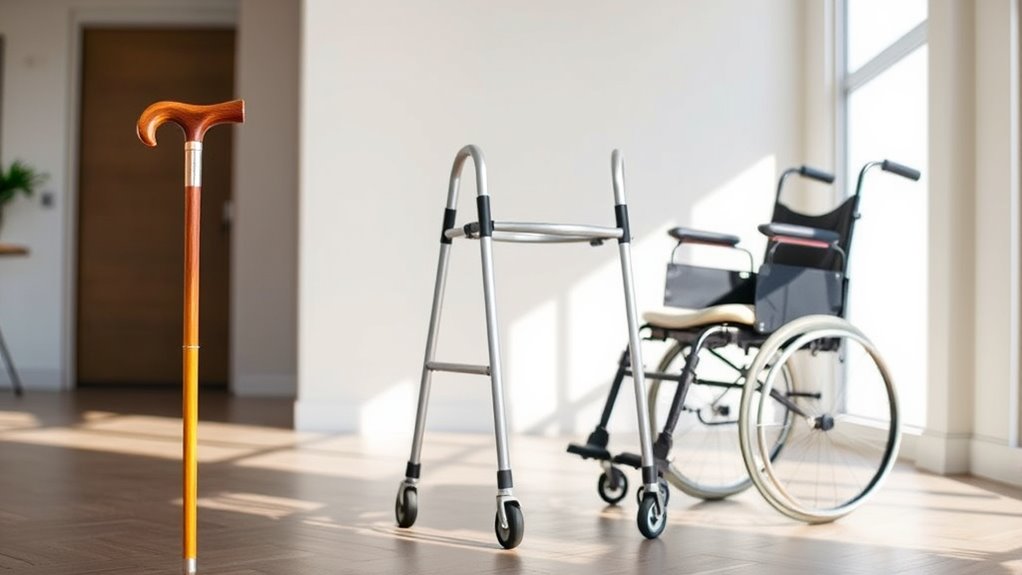
Understanding the different types of mobility aids is essential for finding the right support for your needs. Throughout history, mobility device designs have evolved to meet cultural mobility differences and user preferences. Today, options include canes, walkers, and wheelchairs, each suited to different levels of mobility. For example, the development of advanced electric mobility aids offers greater independence for users with significant mobility challenges. Additionally, considering size restrictions and legal regulations can influence the most appropriate choice for individual circumstances. Recognizing trust issues that may affect a user’s confidence in their mobility device can also be an important factor in choosing the right aid. Moreover, understanding essential oils for comfort and well-being can contribute to a more positive experience with mobility devices. Being aware of cookie usage and privacy considerations ensures that users can make informed decisions about their online data while exploring mobility options.
Considering Your Living Environment and Space Constraints
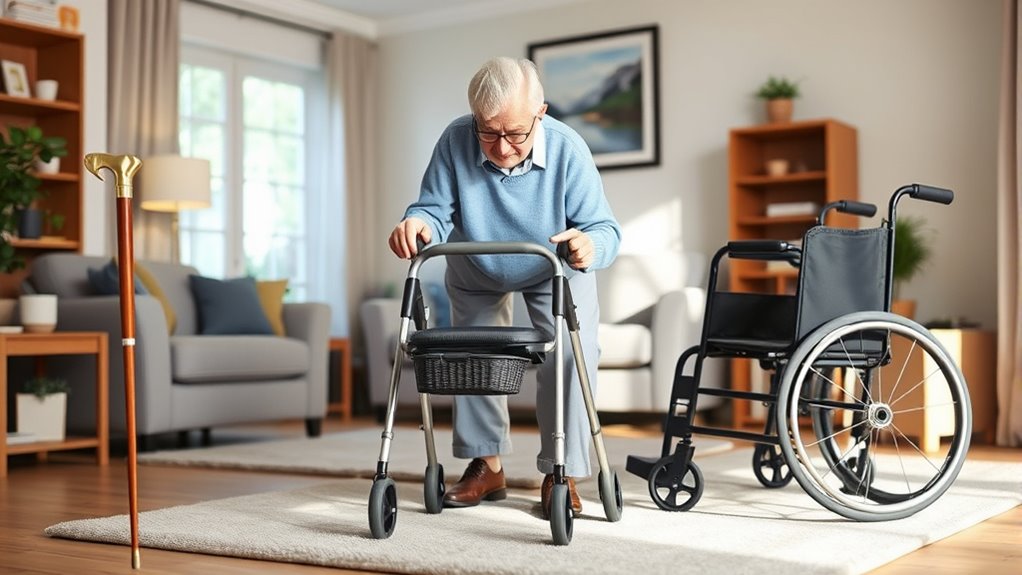
Your living environment plays a crucial role in selecting the right mobility aid, as space limitations and layout can impact ease of use and safety. If your home has narrow hallways or tight corners, a cane or walker with compact design might be best for indoor navigation. Consider how much space you have to maneuver comfortably without obstacles. For outdoor terrain, think about uneven surfaces, slopes, or gravel paths. A wheelchair with sturdy wheels and good suspension can handle rough terrain better, while a cane or walker requires more stable ground. Assess your environment carefully—narrow indoor spaces may favor smaller aids, while outdoor areas with varied terrain might need more robust options. Matching your mobility aid to your living environment ensures safer, more confident movement. Additionally, understanding how home essentials can support safety and accessibility can help in choosing the most suitable mobility device. Recognizing the importance of AI-driven security systems can also provide extra safety measures in your home.
Evaluating Safety Features and Stability

When choosing a mobility aid, prioritizing safety features and stability is vital to prevent falls and guarantee confidence during use. Carefully examine the safety features, such as non-slip grips, brakes, and secure locking mechanisms. Conduct a stability assessment by testing how well the device supports your weight and maintains balance on different surfaces. For walkers and rollators, check for adjustable height settings and sturdy frames. With wheelchairs, ensure the wheels are stable and the brakes are reliable. Look for features like anti-tip bars or wide bases that enhance stability. Remember, a secure and stable mobility aid minimizes the risk of accidents, giving you peace of mind and independence. Always test thoroughly before making your final choice. Additionally, consider testing for proper fit to ensure comfort and optimal support during use.
Analyzing Comfort and Ergonomic Design
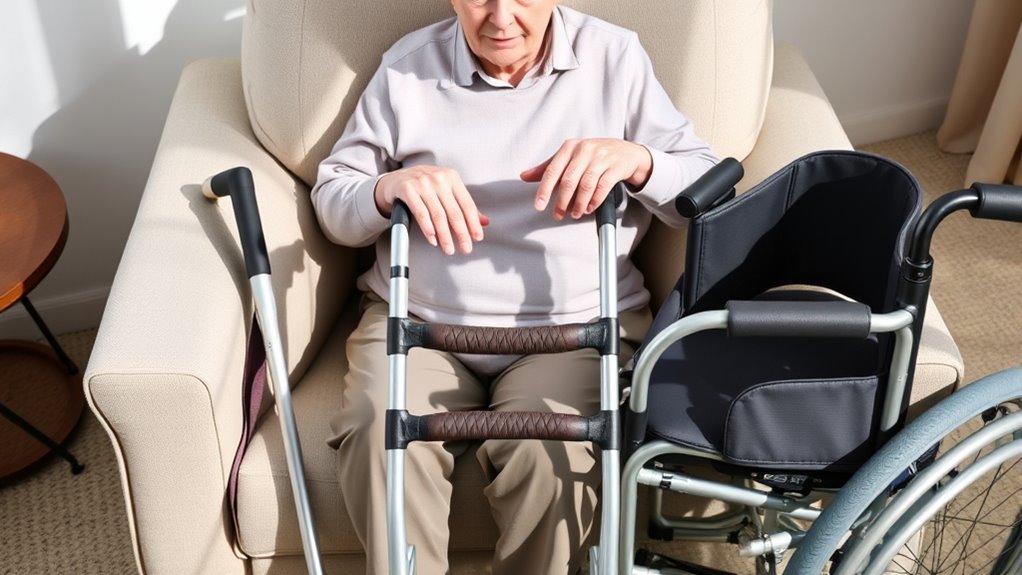
When choosing a mobility aid, you should pay close attention to ergonomic handle design to guarantee a comfortable grip. Cushioning and support are also essential for reducing strain during extended use. These features can make a significant difference in your overall comfort and ease of movement. Additionally, considering the emotional alignment of your mobility choice can help ensure that it supports your independence and confidence. Incorporating ergonomic handle design can further enhance comfort and reduce fatigue during daily activities. Selecting a device with durable, safe materials can also contribute to both safety and long-term usability. Moreover, understanding the Gold IRA Markets can inspire confidence in selecting high-quality, reliable mobility devices that stand the test of time. Ensuring that your device is built with cybersecurity considerations in mind can help protect your personal information and usage data from potential threats.
Ergonomic Handle Design
Have you ever noticed how the shape and material of a handle can make a significant difference in comfort? An ergonomic handle design focuses on maximizing grip comfort and reducing strain. When choosing a mobility aid, consider features like:
- Contoured shapes that fit naturally in your hand
- Soft, non-slip materials to prevent slipping and enhance grip comfort
- Appropriate size and diameter to match your hand strength and size
These aspects help prevent fatigue and discomfort during use. A well-designed ergonomic handle reduces unnecessary pressure on your hand and wrist, making mobility easier and more comfortable. Additionally, the design of ergonomic handles can influence overall safety and ease of use. Considering the materials used in handles can also impact durability and comfort. Remember, the right handle design supports your independence and minimizes pain, so prioritize comfort and fit when selecting your mobility aid.
Cushioning and Support
A well-designed handle isn’t just about shape and material—it also involves proper cushioning and support to enhance comfort. Cushioning comfort is essential to reduce pressure points and prevent fatigue during extended use. Look for support features like padded grips or gel-infused handles, which absorb shock and provide a softer feel. These elements help minimize discomfort, especially if you have sensitive hands or joint issues. The right cushioning can also improve grip stability, preventing slips and accidental falls. When choosing a mobility aid, prioritize handles with supportive padding and ergonomic support features that suit your hand size and strength. This focus on cushioning and support ensures you maintain comfort and confidence while using your device.
Weighing Portability and Storage Options
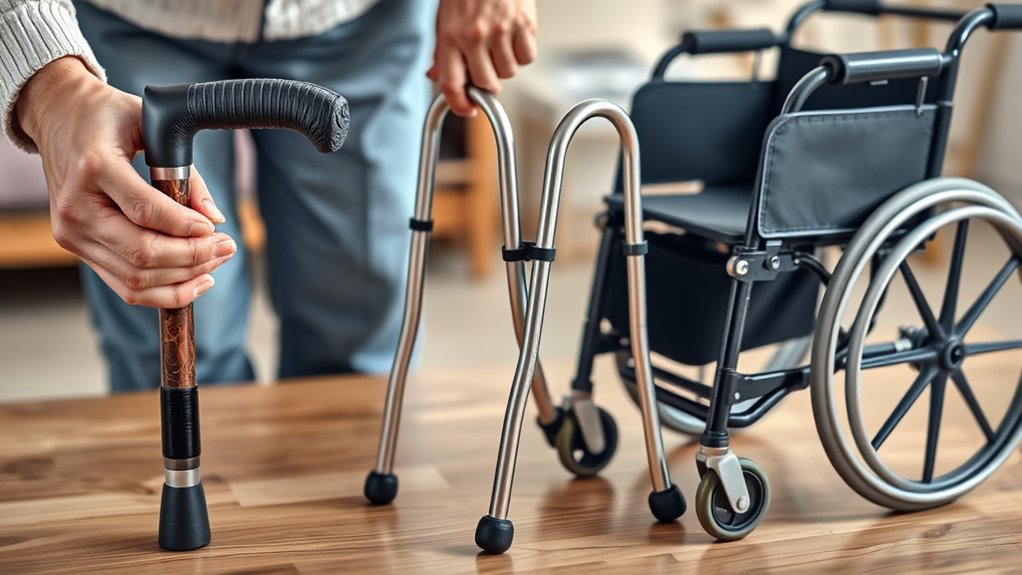
When choosing a mobility aid, consider how easy it is to carry or move around with you. Think about whether it fits comfortably in your vehicle or storage space at home. Balancing portability and storage options guarantees your device is convenient for your daily needs.
Portability for Easy Transport
Ever wondered how easily you can carry or store your mobility aid when not in use? Portability plays a key role in staying active and independent, especially with current mobility trends and advances in assistive technology. A lightweight cane is easy to fold and carry in a bag, making it ideal for quick storage. Foldable walkers are becoming popular, offering compact transport and simple storage options. Wheelchairs, especially portable manual models, are designed for easy folding and quick loading into vehicles. Consider these features:
- Lightweight, foldable design for effortless carrying
- Compact storage options when not in use
- Compatibility with travel accessories and vehicle storage
Choosing a mobility aid with good portability ensures convenience, supports active living, and aligns with modern assistive technology trends.
Storage Space Considerations
Balancing storage space and portability is essential when choosing a mobility aid, as both factors directly impact your daily convenience. If storage space is limited, opt for a device with a compact design that easily fits into your home or car. Walkers with foldable frames or lightweight wheelchairs are excellent choices, as they can be stored discreetly when not in use. Consider how much space you’ll need to store your mobility aid and whether it fits comfortably in your living area or vehicle. A device that combines a compact design with easy storage options helps you maintain independence without cluttering your space. Ultimately, selecting a mobility aid that balances these factors ensures it remains practical and accessible for your daily needs.
Determining Ease of Use and Maneuverability

Evaluating the ease of use and maneuverability of a mobility aid is essential to ensure it fits your daily needs. You want something that feels natural and comfortable to operate. Consider how easily you can steer, turn, and adjust the aid in different environments. Look for features like ergonomic grips, which reduce hand fatigue, and check if the aesthetic design matches your preferences, making you feel confident using it. To assess maneuverability, focus on:
Choose a mobility aid that’s easy to steer, comfortable, and matches your style for safe, confident use.
- The weight and stability of the device
- How smoothly it moves on various surfaces
- The comfort of grips and handles during use
Choosing an aid that’s easy to control enhances independence and safety, so take the time to test different options before deciding.
Consulting Healthcare Professionals for Recommendations

Talking to healthcare professionals is essential when choosing a mobility aid. They can provide personalized recommendations based on your specific needs. Trusting their guidance helps guarantee you find the most suitable and effective solution.
Professional Guidance Matters
Consulting healthcare professionals is a crucial step when choosing a mobility aid, as they can provide personalized advice based on your specific needs and medical condition. They assess your mobility challenges and recommend suitable options that incorporate assistive technology and the latest mobility innovation. This guarantees you select a device that enhances safety, comfort, and independence.
By working with experts, you can explore:
- The most effective assistive technology tailored to your condition
- How mobility innovation can improve your daily life
- Proper usage and safety tips for your chosen aid
Their guidance helps you make an informed decision, avoiding unnecessary frustration or injury, and guarantees you get the best support for your mobility journey.
Personalized Mobility Solutions
Have you considered how expert advice can tailor a mobility aid specifically to your needs? Consulting healthcare professionals ensures you explore customization options that match your mobility requirements and lifestyle. They can recommend features like adjustable height, grip styles, or support levels, providing a more comfortable fit. Additionally, discussing aesthetic preferences helps you select a device that feels right for you, boosting confidence and independence. Personalized solutions make daily use easier and more enjoyable, reducing frustration and discomfort. By working with a professional, you ensure your mobility aid aligns perfectly with your physical needs and personal style. This tailored approach helps you feel more secure and motivated to stay active, ultimately improving your overall quality of life.
Budgeting for Your Mobility Assistance Device

Budgeting for your mobility assistance device is an essential step to guarantee you find a solution that fits both your needs and your finances. Start by doing a cost comparison between different options to find the best value. Check if your insurance coverage can help offset expenses, which can considerably reduce out-of-pocket costs. Consider the following:
- The upfront price of the device
- Long-term maintenance and replacement costs
- Additional accessories or features you might need
Being aware of insurance coverage options and understanding the total cost helps you make an informed decision. Remember, investing in a suitable mobility aid can improve your quality of life without straining your finances. Proper budgeting ensures you get the right device while staying within your financial limits.
Testing and Trying Out Your Chosen Mobility Aid
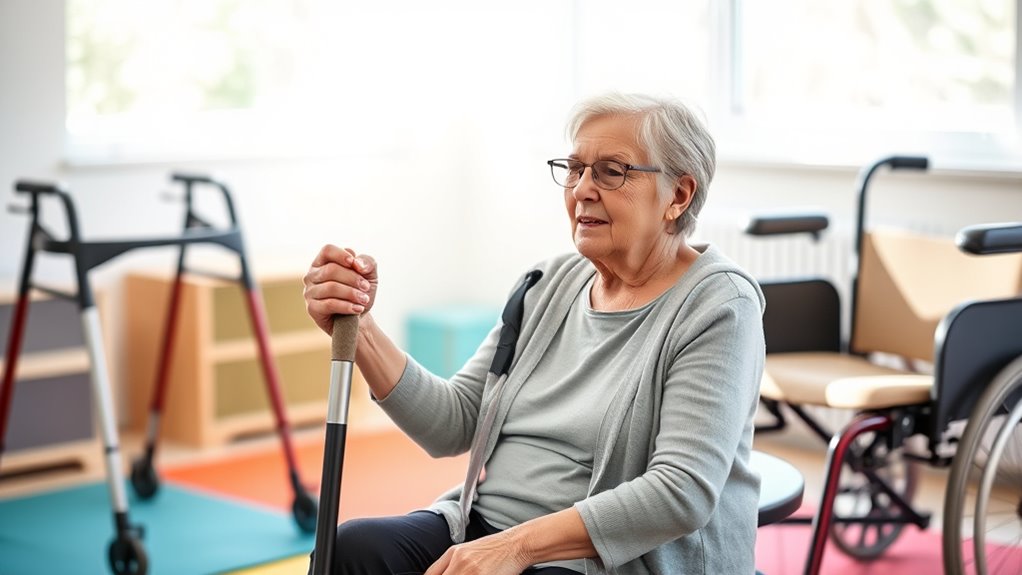
Once you’ve narrowed down your options and considered your budget, it’s time to test and try out your chosen mobility aid. During this process, focus on mobility aid customization to suit your needs and ensure user comfort testing. Sit, stand, and walk with the device to feel how it supports your movements. Adjust height, grips, and other features to maximize comfort and stability. Observe how easily you can maneuver, whether it feels secure, and if any part causes discomfort. Take note of how the aid responds to different surfaces. Here’s a quick overview:
| Feature | Comfort Level | Adjustability |
|---|---|---|
| Cane | Comfortable grip, adjustable height | Easy to customize handle height |
| Walker | Stable, padded grips | Adjustable width and height |
| Wheelchair | Cushioned seat, ergonomic design | Customizable seating and footrests |
| Reliability | Feels sturdy | Easy to modify for comfort |
| Maneuverability | Smooth movement | Adjustable components |
Frequently Asked Questions
How Long Can I Expect My Mobility Aid to Last With Regular Use?
Your mobility aid’s durability expectations depend on its type and usage, but generally, a cane lasts 1-3 years, a walker about 3-5 years, and a wheelchair around 5-10 years with regular use. Proper maintenance can extend its lifespan. Keep an eye on wear and tear, and replace parts as needed to guarantee safety and comfort. Regular inspections help maintain peak performance and longevity of your mobility aid.
Are There Specific Brands Known for Durability and Reliability?
When it comes to brands known for durability and reliability, you get what you pay for—it’s the real deal. Look for companies with a solid reputation and good product warranties, which show they stand behind their products. Some trusted names include Nova, Medline, and Drive Medical. These brands often offer sturdy, long-lasting options, so you won’t have to replace your mobility aid frequently. Remember, choosing quality can make all the difference.
Can I Customize or Personalize My Mobility Aid for Better Comfort?
You can definitely customize your mobility aid for better comfort and aesthetic appeal. Many options let you add personalized comfort features like cushioned grips or ergonomic handles. Aesthetic customization, such as choosing colors or decorative accessories, helps you feel more confident and expressive. Talk to your supplier about available options, and you’ll find ways to make your cane, walker, or wheelchair uniquely suited to your style and comfort needs.
What Maintenance or Upkeep Is Required for Different Mobility Devices?
Maintaining your mobility aid involves regular cleaning requirements, inspecting for wear and tear, and replacing parts when needed. You should routinely wipe down surfaces, check for loose screws, and make certain the wheels or tips are in good condition. Keeping spare replacement parts handy helps you quickly address issues, extend the device’s lifespan, and stay safe. Proper upkeep keeps your mobility aid reliable and comfortable for everyday use.
Are There Any Legal or Insurance Considerations When Purchasing a Mobility Aid?
When you’re selecting a mobility aid, consider insurance coverage and legal requirements. Check if your insurance covers devices like wheelchairs or walkers, and understand any legal standards or documentation needed for approval. You might need a doctor’s prescription or a formal assessment. Being aware of these factors helps guarantee a smooth purchase process and that your device meets safety regulations and insurance policies.
Conclusion
Choosing the right mobility aid balances safety with independence. While a cane offers simplicity and portability, a wheelchair provides comfort for longer distances. Think of it as the difference between walking freely and having a sturdy chair when needed—each has its place. By understanding your needs and environment, you’ll find a device that keeps you moving confidently. Remember, the right aid isn’t just about mobility; it’s about reclaiming your freedom every day.









